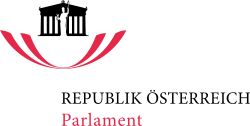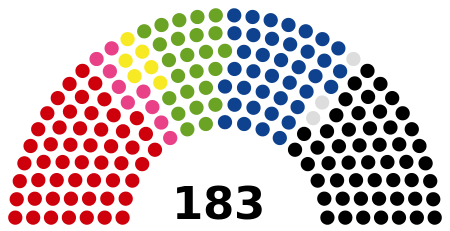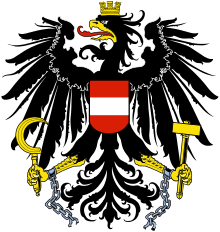National Council (Austria)
| National Council Nationalrat | |
|---|---|
| 24th Legislative Period | |
 | |
| Type | |
| Type |
Lower house of the Austrian Parliament |
| Leadership | |
President | |
Second President | |
Third President | |
| Structure | |
| Seats | 183 |
 | |
Nationalrat political groups |
Government (102): SPÖ (52) ÖVP (50) Opposition (81): FPÖ (38) Grüne (24) Team Stronach (6) NEOS (9) Independent (4) |
| Elections | |
Nationalrat voting system | Proportional representation |
Nationalrat last election | 29 September 2013 |
Nationalrat next election | 2018 or earlier |
| Meeting place | |
 | |
|
Parliament Innere Stadt, Vienna Republic of Austria | |
| Website | |
| parlament.gv.at | |
The National Council (Nationalrat) is one of the two houses of the Austrian Parliament and is frequently referred to as the lower house. The constitution endows the National Council far more power than the Federal Council.
Responsibilities
 |
| This article is part of a series on the politics and government of Austria |
| Constitution |
| Judicial system |
| Foreign relations |
The National Council is where Austria's federal legislative authority is concentrated; for a bill to become federal law, it must be resolved upon by this chamber. Bills passed by the National Council are sent to the Federal Council for corroboration. If the Federal Council approves of the bill or simply does nothing for eight weeks, the bill has succeeded. If the Federal Council vetoes the bill, the National Council may still force it into law by essentially just passing it again; a National Council resolution overruling a Federal Council objection merely has to meet a higher quorum than a regular resolution. In other words, the Federal Council does not have any real power to prevent adoption of legislation, the National Council being trivially able to override it. There are three exceptions to this rule:[1]
- Constitutional laws or regulations limiting the competencies of the federal states
- Laws relating to the rights of the Federal Council itself
- Treaties concerning the jurisdiction of the federal states.
The approval of the National Council is also required for most of the prerogatives of the Federal Assembly to be exercised. For example, motions to call for a referendum aimed at having the President removed from office by the electorate, and motions to declare war all need a two-thirds majority in the National Council. Only motions to impeach the President can also be from the Federal Council.[2]
Elections
The 183 members of the National Council are elected by nationwide popular vote for a term of five years; each Austrian sixteen years or older on the day the election takes place is entitled to one vote. National Council elections are general elections. The voting system aims at party-list proportional representation, uses partially open lists, and is relatively straightforward:
- For the purpose of National Council elections, the nine states of Austria comprise regional electoral districts. The nine regional electoral districts are subdivided into a total of 43 local electoral districts. Political parties submit separate ranked lists of candidates for each district, regional or local, in which they have chosen to run. They also submit a federal-level list.
- Votes cast are first counted within their local electoral districts. Since there are 43 local districts but 183 seats to fill, most local districts are multi-member districts. The number of seats assigned to each local district is based solely on electoral district population, as established by the most recent census; the partitioning and apportionment rules are simple enough to prevent gerrymandering from becoming an issue. The number of votes required to win one seat is simply the number of votes divided by the number of seats assigned to the district in question. For example, if 150,000 votes are cast in a five-seat local district, it takes 30,000 votes to win one seat. If a party has scored 61,000 votes out of the 150,000 votes cast, it is entitled to two seats, to be taken by the first two candidates on the party's local district list. Since 60,000 votes would have been sufficient to win two seats, 1000 votes are left unaccounted for by this first round of tallying.
- Any vote not accounted for on the local level is dealt with on the regional level, provided that the party it has been cast for has obtained at least four percent of the regional total vote. The system is analogous to that used on the district level; the number of seats assigned to a regional district is simply the number of seats assigned to one of its constituent local districts but not filled during the first round of tallying.
- Any vote not accounted for on the regional level either is dealt with on the federal level, provided that the party it has been cast for has obtained at least four percent of the federal total vote. The D'Hondt method is used to allocate any National Council seats remaining to be filled.
In addition to voting for a party list, voters may express preference for one individual candidate. A candidate receiving sufficiently many personal votes can rise in rank on his or her district party list; voters thus have a certain degree of influence as to which particular individual wins which particular seat. It is not possible, however, to simultaneously vote for party X but exert influence on the candidate rankings on the party list of party Y.
Peculiarities

Austria's federal constitution defines Austria to be a semi-presidential democracy: the executive branch of government is supposed to be headed by the President but also be answerable to the legislative branch. In practice, however, Austria's President plays no role in the administration, which is left to the Chancellor and Cabinet, which are dependent on the confidence of the National Council. While the President has the theoretical authority to dissolve a hostile National Council, constitutional convention prevents this power from being exercised except on the advice of the Chancellor. Austria accordingly functions as a parliamentary democracy: for all intents and purposes, the cabinet is subject to approval by the National Council, the president being little more than a figurehead.
A related discrepancy between Austrian constitutional theory and Austrian political practice is that the constitution defines the President of the National Council to be Austria's second highest public official, junior only to the president proper. As a practical matter, the President of the National Council is a representative of rather moderate significance: wielding less power than the president by extension means wielding less power than the Chancellor or even most federal ministers. The President of the National Council thus serves mostly as a more or less nonpartisan moderator of parliamentary debate.
Latest election
| Parties | Votes | +/− | % | +/− | Seats | +/− | |
|---|---|---|---|---|---|---|---|
| Social Democratic Party of Austria (Sozialdemokratische Partei Österreichs) | 1,258,605 | −171,601 | 26.82 | −2.44 | 52 | −5 | |
| Austrian People's Party (Österreichische Volkspartei) | 1,125,876 | −143,780 | 23.99 | −1.99 | 47 | −4 | |
| Freedom Party of Austria (Freiheitliche Partei Österreichs) | 962,313 | +105,284 | 20.51 | +2.97 | 40 | +6 | |
| The Greens – The Green Alternative (Die Grünen – Die Grüne Alternative) | 582,657 | +72,721 | 12.42 | +1.99 | 24 | +4 | |
| Team Stronach (Team Stronach für Österreich) | 268,679 | New | 5.73 | New | 11 | New | |
| NEOS – The New Austria (NEOS – Das Neue Österreich) | 232,946 | New* | 4.96 | New* | 9 | New* | |
| Alliance for the Future of Austria (Bündnis Zukunft Österreich) | 165,746 | -357,187 | 3.53 | –7.17 | 0 | –21 | |
| Communist Party of Austria (Kommunistische Partei Österreichs) | 48,175 | +10,813 | 1.03 | +0.27 | 0 | — | |
| Pirate Party of Austria (Piratenpartei Österreichs) | 36,265 | New | 0.77 | New | 0 | New | |
| Christian Party of Austria (Christliche Partei Österreichs) | 6,647 | –24,433 | 0.14 | –0.50 | 0 | — | |
| Others | 4,998 | — | 0.11 | — | 0 | — | |
| Invalid/blank votes | 89,503 | –14,140 | — | — | — | — | |
| Total | 4,782,410 | –208,542 | 100.0 | — | 183 | — | |
| Registered voters/turnout | 6,384,308 | 74.91 | –3.90 | — | — | ||
| Source: Austrian Interior Ministry | |||||||
Current Make-up of the National Council

| Party | Members | |
| SPÖ | 52 | |
| ÖVP | 51 | |
| FPÖ | 38 | |
| Grüne | 24 | |
| Team Stronach | 6 | |
| NEOS | 9 | |
| Independent | 3 | |
| Total |
183 | |
Four members switched from Team Stronach to ÖVP; another one became independent. Two members left FPÖ to become unattached as well.[3][4][5]
See also
- List of Presidents of the National Council of Austria
- Federal Assembly (Austria)
- Federal Council (Austria)
- Politics of Austria
- List of legislatures by country
References
- ↑ "The Responsibilities of the Federal Council – The Federal Council's Right of Objection". Website of the Austrian Parliament. Retrieved 2010-10-04.
- ↑ "Federal Assembly - Responsibilities and Legal Principles". parlament.gv.at. Retrieved 18 May 2010.
- ↑ http://derstandard.at/2000020092796/Nachbaur-und-Ertlschweiger-wechseln-von-Stronach-in-OeVP-Klub
- ↑ http://diepresse.com/home/politik/innenpolitik/4746168/StronachAbgeordnete-Franz-und-Vetter-laufen-zur-OVP-uber?_vl_backlink=/home/index.do
- ↑ http://www.parlament.gv.at/WWER/NR/
External links
| Wikimedia Commons has media related to National Council of Austria. |
- Official website (English)
- National Council Elections Statute, official rules and regulations (German)